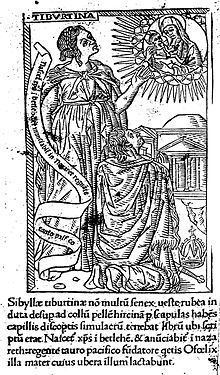 | ||
The Tiburtine Sibyl or Albunea was a Roman sibyl, whose seat was the ancient Etruscan town of Tibur (modern Tivoli).
Contents
The mythic meeting of Cæsar Augustus with the Sibyl, of whom he inquired whether he should be worshiped as a god, was a favored motif of Christian artists. Whether the sibyl in question was the Etruscan Sibyl of Tibur or the Greek Sibyl of Cumæ is not always clear. The Christian author Lactantius identified the sibyl in question as the Tiburtine sibyl. He gave a circumstantial account of the pagan sibyls that is useful mostly as a guide to their identifications, as seen by 4th century Christians:
The prophecy of the Emperor Constans
An apocalyptic pseudo-prophecy exists among the Sibylline Oracles, attributed to the Tiburtine Sibyl, written c. 380 AD, but with revisions and interpolations added at later dates. It purports to prophesy the advent in the world's ninth age of a final Emperor vanquishing the foes of Christianity:
Then will arise a king of the Greeks whose name is Constans. He will be king of the Romans and the Greeks. He will be tall of stature, of handsome appearance with shining face, and well put together in all parts of his body...
This Emperor's reign is characterized by great wealth, victory over the foes of Christianity, an end of paganism and the conversion of the Jews. The Emperor having vanquished Gog and Magog,
After this he will come to Jerusalem, and having put off the diadem from his head and laid aside the whole imperial garb, he will hand over the empire of the Christians to God the Father and to Jesus Christ his Son.
In doing so, he will give way to the Antichrist:
At that time the Prince of Iniquity who will be called Antichrist will arise from the tribe of Dan. He will be the Son of Perdition, the head of pride, the master of error, the fullness of malice who will overturn the world and do wonders and great signs through dissimulation. He will delude many by magic art so that fire will seem to come down from heaven. ... When the Roman Empire shall have ceased, then the Antichrist will be openly revealed and will sit in the House of the Lord in Jerusalem.
The prophecy relates that Antichrist would be opposed by the Two Witnesses from the Book of Revelation, identified with Elijah and Enoch; after having killed the witnesses and started a final persecution of the Christians,
the Antichrist will be slain by the power of God through Michael the Archangel on the Mount of Olives.
Frescoes at the Villa d'Este
Ippolito II d'Este rebuilt the Villa d'Este at Tibur, the modern Tivoli, from 1550 onward, and commissioned elaborate fresco murals in the Villa that celebrate the Tiburtine Sibyl, as prophesying the birth of Christ to the classical world.
